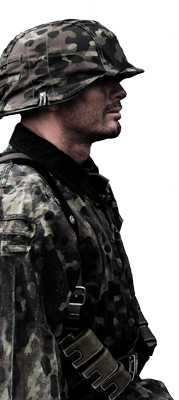D-Day landings
The D-Day landings, consisting of air and amphibious assaults, are considered one of the largest invasions in military history.
The day before
The day before D-day meant different things to many people. 287,000 men and countless armoured vehicles had boarded the ships, some of them already in the first days of the month. Some of them had been cut off from the outside world for some time; they saw no sky and no sea, no daylight and no darkness. They felt sick, they were tired and thousands of thoughts ran through their heads. They knew that the time would come when they would be spat out on a strange coast full of deadly elements, a coast that would be under a murderous fire.
Operation Neptune
On 1 February, Montgomery, Ramsay and Leigh-Mallory drew up the Initial Joint Plan, Operation Neptune, ‘an executive instrument’ relating to the expansion of Operation Overlord. The air forces had already begun ‘the preparatory phases of the battle.
The Navy had begun administrative planning in 1942, and the entire framework of the extensive task of Navy transport, attack and defence had already been worked out in detail. Adjustments and extensions to those plans would continue until D-Day, and even beyond.
The armies involved faced an unimaginable task. The American 1st Army and the British 2nd Army presented their attack plans on February 25 and March 20 respectively. From then on, detailed plans could be drawn up at all levels.
Airborne landings
The airborne landings were assigned to three divisions and were carried out on the night of June 5-6 before the amphibious landings began.
The British airborne landings with the 6th Airborne Division took place to the east of the amphibious landing zones. Their objective was to secure the bridges of the river Orne, cut the lines of communication and capture the Merville Battery among others.
The American airborne assaults took place with the 101st and 82nd Airborne Divisions west of the amphibious landing zones, mainly to capture communication lines and bridges.
These actions secured the two flanks of the invasion. This prevented the Germans from sending reinforcements to the future Allied bridgehead. The battle for that bridgehead (a foothold) was fought on the beaches the next morning.
Amphibious landings and beaches on D-Day
The amphibious landings on D-Day can be divided into five zones or beaches. On each of these beaches divisions were assigned, each with a target.
The British were assigned Sword beach and Gold beach. The Canadians Juno beach. Here the landings on the beach were not too difficult. But they had to secure the beach house by house, so they lost a lot of time and troops.
The Americans were given the beaches Omaha beach and Utah beach. Especially on Omaha beach the most casualties fell. The German defence here was much more stubborn. The landing on Utah beach went without much difficulty. Partly because they landed on the wrong part of the beach because of the current. Coincidentally, this part was less well defended than the original target. In between, the American rangers had the objective to take out six guns on Pointe du Hoc that could reach both Omaha and Utah beach.
Factions during the D-Day landings
For both the Allies and the Germans, D-day could be described as the longest day. Both factions lost considerable numbers of men.

Allies
Most people know that the Americans, British and Canadians in particular were part of the Western Allies on D-Day. But smaller countries also played an important role in their contribution to this historic day.

Germans
Only when it was too late did the Germans take structured action. But because of the weakened Luftwaffe and Kriegsmarine, these actions could not be adequately supported.
Result of the landings on D-day
The beginning of the end of the Second World War, that is how this important day in our history is often described. For many it was one of the longest, most difficult and most important days this war has known. The fate of Europe was partly determined by the outcome of D-day.
